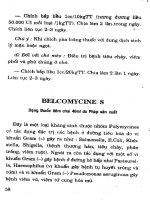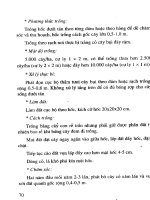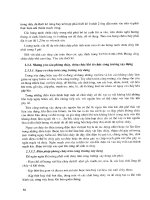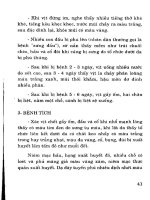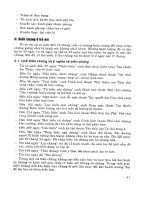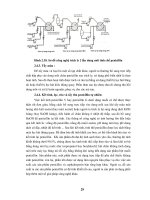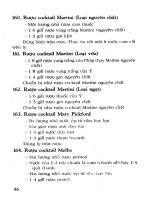Jossey-Bass Teacher - Math Wise Phần 5 pps
Bạn đang xem bản rút gọn của tài liệu. Xem và tải ngay bản đầy đủ của tài liệu tại đây (610.69 KB, 45 trang )
Copyright © 2010 by John Wiley & Sons, Inc.
Decimal Squares
162 Computation Connections
Chapter 44
Square Scores
Grades 2–8
Ⅺ Total group activity
Ⅺ
× Cooperative activity
Ⅺ Independent activity
Ⅺ Concrete/manipulative activity
Ⅺ
× Visual/pictorial activity
Ⅺ
× Abstract procedure
Why Do It:
Students will practice with addition, subtraction, multiplica-
tion, or division facts, using logical-thinking strategies in a
game setting.
You Will Need:
Square Score Grids (provided at the end of this activity) are
required. Usually one per pair of students is enough to start
with. Once they are familiar with the activity, players might
also devise grids for each other (see Extensions). Pencils and
pens of different colors are also needed.
HowToDoIt:
Square Scores is usually played by two students on one grid.
The grid contains 5 rows and 7 columns of dots. In the
middle of a group of four adjacent dots is a math problem.
Each student uses a pencil or pen of a different color, and at
her or his turn draws a vertical or horizontal line between any
two adjacent dots. Play continues in this manner until a line
is drawn that closes a square. The student who draws that
line must attempt to answer the problem contained within
163
that box. If the problem is answered correctly, that student is allowed
to claim the square and to shade or mark it. If the student gives an
incorrect answer, the square is marked with an X and no credit is
allowed. (Students might check their answers with a calculator or an
answer sheet.) When all squares are closed, the students count the boxes
claimed to see how many facts they knew.
Example:
The players pictured below are practicing their multiplication facts for
6s, while also attempting to capture as many squares as possible. Thus
far Juanita has captured and marked the three squares marked \\\\,and
Jose has claimed the two facts marked ////.
Extensions:
1. If students need practice with a certain operation, such as sub-
traction, then the grid should utilize only those types of problems.
However, if mixed practice is desirable, a different grid might
include a combination of addition, subtraction, multiplication, or
division or even fractions or decimals.
164 Computation Connections
2. Square Scores also works well as a team game when it is played on
the overhead projector. In such a setting, the team members are
allowed a strategy conference (for two minutes), and then the team
leader draws the line for that turn. Play continues in this manner
until all squares on the overhead transparency are surrounded and
marked. The winning team is the one that has captured the most
squares.
3. Players can easily devise their own grids by writing equations
designated for practice on blank grids (see model provided) or
by using one-inch or larger graph paper. (Note: The grid designer
should also create an answer key.) The designed grid can be
photocopied and tried by several other players.
4. Advanced levels of the game might include having three, four, or
more players competing on the same grid, and could include bonus
squares (enclosing problems more difficult than those typical for
the grade or age level.
Square Scores 165
Copyright © 2010 by John Wiley & Sons, Inc.
SQUARE SCORE ADDITION AND SUBTRACTION
2 + 3 1 + 43 + 74 – 46 – 25 + 1
5 + 5 3 + 36 – 38 + 22 + 26 – 4
7 – 4 4 + 23 + 67 – 54 + 45 + 6
2 + 5 9 – 23 + 85 + 56 + 69 – 5
Copyright © 2010 by John Wiley & Sons, Inc.
SQUARE SCORE MULTIPLICATION AND DIVISION
5 × 5 6 × 27 × 412 ÷ 34 × 615 ÷ 3
2 × 7 9 × 718 ÷ 26 × 627 ÷ 95 × 8
45 ÷ 9 24 ÷ 86 × 936 ÷ 435 ÷ 77 × 8
9 ÷ 3 9 × 23 × 860 ÷ 106 × 89 × 7
CREATE YOUR OWN SQUARE SCORE GRID
Square Scores 167
Chapter 45
Math Concentration
Grades 2–8
Ⅺ
× Total group activity
Ⅺ
× Cooperative activity
Ⅺ Independent activity
Ⅺ Concrete/manipulative activity
Ⅺ
× Visual/pictorial activity
Ⅺ
× Abstract procedure
Why Do It:
Students will make connections between mathematical terms,
numbers, basic facts, and geometric figures.
You Will Need:
Small cards (3- by 5-inch index cards, for example) and
marking pens are required.
How To Do It:
Give each player two or four cards. Each player will then
select a math fact or concept, such as 3 × 4, and on their
cards will represent this fact in different ways. When all the
players’ cards are ready, they are shuffled together and placed
face down in rows and columns. A player then turns up two
cards; if the player can ‘‘prove’’ a match, he or she gets to
keep the cards and try again. If not, the cards are returned
to their spots, and Math Concentration continues with the next
player. The player holding the most cards at the end of the
game wins.
168
Examples:
1. These cards match the two
concepts perpendicular and
intersecting with a drawing.
intersecting
perpendicular
lines
2. A dot diagram, an addition problem, a multiplication fact, and the
numeral itself have been used as four ways to represent 20 for
the game depicted below.
5
×4
20
10 + 10
Extensions:
1. Students can match equivalent fractions, fractions with decimals,
fractions or decimals with percentages, and so on.
2. Together with either English or metric rulers, students can match
measurements with pictures or drawings of corresponding lengths
(for example, pairing 2 inches with a circle of that diameter).
3. Simple word problems and solutions can be paired. ‘‘Tricky’’
problems, such as the following, can be fun too: ‘‘How much dirt
can be taken from a hole 6 feet long by 2 feet wide by 1 foot deep?
Answer: NONE! Reason: It is a hole, so the dirt is already gone.
Math Concentration 169
Chapter 46
Scramble
Grades 2–8
Ⅺ
× Total group activity
Ⅺ
× Cooperative activity
Ⅺ Independent activity
Ⅺ Concrete/manipulative activity
Ⅺ Visual/pictorial activity
Ⅺ
× Abstract procedure
Why Do It:
This activity helps reinforce students’ grasp of addition, sub-
traction, multiplication, and division facts, and requires them
to practice mental and pencil-and-paper computation.
You Will Need:
Copies of Scramble Cards (reproducibles provided) are
required.
How To Do It:
Scramble is usually played with two to four teams of ten
people. Each team member holds a single, colored card with
a numeral from 0 to 9 on it; the cards for one team might
be red, another team green, and so on. The teacher calls out
a number problem and the students from each team who
are holding the correct answer numerals ‘‘scramble’’ (walk
or run) to the answer area for their team. The answer area
might be in front of the classroom or in opposite corners of the
classroom, or even in designated places outside. The teacher
at some point calls out ‘‘Freeze,’’ and at this point students
have to freeze in their positions. Each team achieving a correct
answer receives a point, and the first team to do so is also
170
given a bonus point. In the case of a tie, each tying team receives one
bonus point. The team with the highest score wins.
Example:
In the situation shown below, the leader has called out 8 +9. The Red
Team players with the 1 and the 7 have scrambled to their answer
location to show 17 as the proper answer, and have received a point for
the correct answer plus a bonus point for being first. The Green Team
has the correct numerals, but in the wrong order; if they reorder before
the leader says ‘‘Freeze,’’ they might still get one point.
Extensions:
If simple questions are called out, it is quickest for students to do these
in their heads. For more difficult ones, the teams may talk them through,
use pencil and paper to help find answers, or use calculators. Have
students try some of the following problems (or any other appropriate
problems), and allow them to design problems of their own.
Scramble 171
1. Addition:
Basic facts 3 +4 = 5 +5 = 7 +8 =
No carrying 12 +12 = 33 +11 +21 = 132 + 246 =
With carrying 8 +13 = 25 +26 = 98 +103 =
2. Subtraction:
Basic facts 7 −2 = 12 −9 = 13 −5 =
No borrowing 24 −12 = 46 −31 = 147 −22 =
With borrowing 33 −24 = 87 −19 = 312 −215 =
3. Other:
Multiplication or
division
7 ×9 = 96 ÷12 =
Mixed (5 ×8) +
(the days in a week) −
13 =
Nontraditional (Only show the remainder
from 108 ÷12)
172 Computation Connections
Copyright © 2010 by John Wiley & Sons, Inc.
SCRAMBLE CARDS
Chapter 47
Palindromic Addition
Grades 2–8
Ⅺ
× Total group activity
Ⅺ
× Cooperative activity
Ⅺ
× Independent activity
Ⅺ Concrete/manipulative activity
Ⅺ Visual/pictorial activity
Ⅺ
× Abstract procedure
Why Do It:
This activity provides a challenging and interesting way to
practice addition.
You Will Need:
Although pencils and paper are the only materials required,
the ‘‘Guide to Palindromic Sums’’ for numbers less than 1,000
(at the end of this activity) will likely prove helpful.
How To Do It:
1. To begin, demonstrate the activity to students by select-
ing a number less than 1,000 that is not palindromic
(reversible) and adding the number to it that is obtained
by reversing its digits (for example, if 158 is the selected
number, add 851 to it). Continue manipulating the
resulting sums in this manner until a palindromic
sum (a sum that reads the same in either direction)
is attained.
174
2. As students begin to work in small groups or individually, it is
suggested that they work with 3- or 4-step solution numbers for
their initial attempts (see the ‘‘Guide to Palindromic Sums’’). Also,
at least two students should work together on each problem so that
they can compare and check their work. Players who are ready
can then go on to try problems of 6, 8, 10, or even 24 steps!
Examples:
1. A palindromic sum is achieved here in 3 steps.
158
+851
1009
+9001
10010
+01001
11011
2. Here, 6 steps are necessary.
847
+748
1595
+5951
7546
+6457
14003
+30041
44044
176
+671
79
+97
Extensions:
1. Young players who are able to add can work with numbers lower
than 20.
2. Also look for words that are palindromes (for example, mom, dad,
and level). This is not mathematical, but a way to connect what
the class is doing in math to words and their spellings.
3. Find out what happens when a palindrome is added to itself in the
first step (for example, 88 +88 = 176, and 176 +671 = 847, and
847 +748 =
,andsoon).
Palindromic Addition 175
4. Challenge students to find a palindromic sum in exactly 7 steps,
for example, or to discover a palindromic sum having more than
13 digits (see 89 or 98 in the ‘‘Guide to Palindromic Sums’’).
5. Have students determine color-coded patterns for the numbers
from 1 to 100 on either 99s or 100s charts, as printed below. Enlarge
and duplicate copies of the following charts, allow the players to
select their own color schemes, and have them individually or in
small groups shade in the patterns on the charts.
90
80
70
60
50
40
30
20
10
9997 98969594
Try a 99s Chart
Choose a color for each Choose a color for each
Try a 100s Chart
939291
8987 88868584838281
7977 78767574737271
6967 68666564636261
5957 58565554535251
4947 48464544434241
3937 38363534333231
2927 28262524232221
1917 18161514131211
978654321
9997 98969594939291
8987 88868584838281
7977 787675
74737271
6967 68666564636261
5957 58565554535251
4947 48464544434241
3937 38363534333231
2927 28262524232221
1917 18161514131211
9786543210
100
90
80
70
60
50
40
30
20
10
176 Computation Connections
Copyright © 2010 by John Wiley & Sons, Inc.
Guide to Palindromic Sums
158, 257, 356, 455, 544, 653, 752, 851, 950
168, 267, 366, 465, 564, 663, 762, 861, 960
178, 277, 376, 475, 574, 673, 772, 871, 970
199, 298, 397, 496, 694, 793, 892, 991
249, 348, 447, 546, 645, 744, 843, 942
299, 398, 497, 596, 695, 794, 893, 992
156, 255, 354, 453, 552, 651, 750
157, 256, 355, 553, 652, 751, 850
186, 285, 384, 483, 582, 681, 780
349, 448, 547, 745, 844, 943
389, 488, 587, 785, 884, 983
399, 498, 597, 795, 894, 993
439, 538, 637, 736, 835, 934
449, 548, 647, 746, 845, 944
489, 588, 687, 786, 885, 984
499, 598, 697, 796, 895, 994
155, 254, 452, 551, 650
164, 263, 362, 461, 560
165, 264, 462, 561, 660
184, 283, 382, 481, 580
185, 284, 482, 581, 680
194, 293, 392, 491, 590
59, 68, 86, 95
180
"sum" numbers
11,011
13,431
15,851
3,113
5,115
5,335
6,666
8,888
6,996
7,337
7,117
7,557
9,119
9,559
9,339
9,779
4,444
2,662
4,884
2,552
4,774
2,992
1,111
747
174, 273, 372, 471, 570
175, 274, 472, 571, 670
195, 294, 492, 591, 690
69, 78, 87, 96
539, 638, 836, 935
579, 678, 876, 975
599, 698, 896, 995
629, 728, 827, 926
649, 748, 847, 946
679, 778, 877, 976
699, 798, 897, 996
183, 381, 480
192, 291, 390
729, 927
749, 947
769, 967
789, 987
819, 918
839, 938
280
290
5,115
9,559
9,339
4,884
25,652
23,232
22,022
45,254
44,044
47,674
46,464
13,431
6,996
69,696
68,486
67,276
66,066
89,298
88,088
2,662
2,5552
3 steps
4 steps
(Continued)
Palindromic Addition 177
Copyright © 2010 by John Wiley & Sons, Inc.
Guide to Palindromic Sums (continued)
"sum" numbers
182, 281, 380
79, 97
779, 977
799, 997
889, 988
45,254
44,044
475,574
449,944
881,188
6 steps
188, 287, 386, 485, 584, 683, 782, 881, 980
197, 296, 395, 593, 692, 791,890
190
233,332
881,188
45,254
7 steps
589, 688, 886, 985
193, 391, 490
1,136,311
233,332
8 steps
829,92888,555,58810 steps
167, 266, 365, 563, 662, 761, 86088,555,588
11 steps
849, 9488,836,886,388
14 steps
177, 276, 375, 573, 672, 771, 8708,836,886,388
15 steps
739, 937
899, 998
5,233,333,325
133,697,796,331
17 steps
869, 9688,813,200,023,18822 steps
187, 286, 385, 583, 682, 781, 880
879, 978
8,813,200,023,188
8,802,236,322,088
23 steps
89, 988,813,200,023,18824 steps
198, 297, 396, 495, 594, 693, 792, 891, 990
166, 265, 364, 463, 562, 661, 760
176, 275, 374, 473, 572, 671, 770
549, 648, 846, 945
639, 738, 837, 936
79,497
45,254
44,044
59,895
99,099
5 steps
178 Computation Connections
Chapter 48
Paper Clip Division
Grades 3–8
Ⅺ
× Total group activity
Ⅺ
× Cooperative activity
Ⅺ
× Independent activity
Ⅺ
× Concrete/manipulative activity
Ⅺ
× Visual/pictorial activity
Ⅺ
× Abstract procedure
Why Do It:
Students will have a concrete, 1-to-1 experience as they solve
division problems. This experience will help them internalize
the meaning of division.
You Will Need:
This activity requires one or more boxes of paper clips, and
pencils and paper.
HowToDoIt:
Have students separate groups of paper clips in order to
practice division, beginning with the Examples below. Also
have them use pencil and paper to record their results.
Examples:
Guide students through the following problems.
1. For 12 ÷2, have students take 12 paper clips and divide
them into 6 groups of 2. In this case, they should
179
take 2 paper clips out of 12 and set them aside,
then keep doing this until they cannot take 2
anymore. The number of groups of 2 is the
answer, which is 6, and because there are no
leftover clips, there is no remainder.
(shows 2 )12
12
0
6
)
2. For 44 ÷ 7, have students use 44 paper clips and put them into
groups of 7. You will get 6 groups of 7, plus 2 extra paper clips.
(shows 7 )44
42
2
6
)
Extensions:
Students should work with paper clips and then with numbers to com-
plete the following problems. Have them share their findings with the
group, the leader, or other players.
1. Count out 25 clips and divide them into groups of 5. → 5
25.
2. Show 21 ÷6 with clips. → 6
21
3. Show 9
63 with clips and then with numbers.
4. Use 2 boxes of paper clips to show 198 divided by 37. → 37
198
180 Computation Connections
5. Examples 1–4 all involved measurement division (when you know
the number in a set but not the number of sets). Also try some
problems concerning partitive division (when you know the num-
ber of sets but not the number in each set). The following problems
illustrate the difference.
(Measurement Division)
2 each
)12
12
0
6
people get apples
apples
(Partitive Division)
2 people
)12
12
0
6
apples per person
apples
6. Make up some paper clip problems of your own and share them
with the class.
Paper Clip Division 181
Chapter 49
IHave ,
Who Has
?
Grades 3–8
Ⅺ
× Total group activity
Ⅺ
× Cooperative activity
Ⅺ Independent activity
Ⅺ Concrete/manipulative activity
Ⅺ Visual/pictorial activity
Ⅺ
× Abstract procedure
Why Do It:
This activity will enhance students’ mental-math computation
abilities, provide focused reviews of math facts, and promote
logical-thinking skills.
You Will Need:
Index cards or card stock to make playing cards and mark-
ing pens to write on the cards are required. (Reproducible
handouts are also provided.)
How To Do It:
A sequential set of IHave , Who Has ? playing cards,
with one card per student, needs to be prepared in advance.
(You are also provided with sample cards for thirty students,
which include a variety of question types, along with a
blank form for creating new cards.) The cards should be
well mixed and then randomly distributed. A designated
leader starts the activity by calling out the ‘‘Who has
’’
(question) from his or her card. All the other players then
182
look at the ‘‘I have ’’ (answer) portions of their cards to see whether
they might have the correct response. The player with the proper answer
then calls out his or her ‘‘I have ’’ (correct answer), and, if all agree, then
reads aloud the ‘‘Who has
’’ (new question) portion of his or her
card. Play continues in this manner until each player has both correctly
answered a question (assistance may be provided) and has asked a
question of the other players. (Note: If there are exactly the same number
of playing cards and players, the final answer will be on the designated
leader’s card. In other words, play will come back to the leader. If there
are more cards than players, some players should hold two cards.)
Example:
In the situation shown here
(for just four players), John, as
the designated leader, called
out ‘‘Who has 8 +9
?’’ Sara
responded, ‘‘I have 17
’’ and,
after a pause to determine if all
agreed, read aloud, ‘‘Who has
the number of wheels on 4 tri-
cycles?’’ In turn, Amber
responded, ‘‘I have 12
,’’
and then called out, ‘‘Who
has 6 ×4 −5
?’’ Jose read,
‘‘I have 19
,’’ and then
asked, ‘‘Who has the
number of ears on 8 students?’’
John stated, ‘‘I have 16
.’’ This
completed the game, because
John, as the leader, had asked
the first question and now had
answered the final question.
Extension:
The following IHave , Who Has ? activity has been set up
with relatively easy problems. Cut out the cards, distribute one to each
player (if there are fewer than thirty players, some may need to hold
more than one card), and allow the students to play and enjoy this
sample game while also learning the procedure. Next, make copies of
the blank game cards; fill in appropriate questions and responses so
that students can enjoy playing while also enhancing mental-math and
logical-thinking skills. (Note: If the students are able, challenge them to
create their own cards.)
IHave , Who Has ? 183
Copyright © 2010 by John Wiley & Sons, Inc.
I Have ,WhoHas ?
I HAVE 100
WHO HAS 2 + 2?
I HAVE 3
WHO HAS 30 – 4?
I HAVE 27
WHO HAS the number of ears on
8 students?
I HAVE 30
WHO HAS 15 – 5?
I HAVE 11
WHO HAS 6 + 6?
I HAVE 21
WHO HAS 11 + 11?
I HAVE 8
WHO HAS the number of legs on
5 dogs?
I HAVE 15
WHO HAS 4 × 7?
I HAVE 29
WHO HAS 10 + 10 + 3?
I HAVE 24
WHO HAS the number of sides on
a hexagon?
I HAVE 14
WHO HAS 5 + 5 + 3?
I HAVE 18
WHO HAS 20 – 3?
I HAVE 1
WHO HAS 30 – 28?
I HAVE 7
WHO HAS 5 x 5?
I HAVE 9
WHO HAS 20 – 1?
I HAVE 2
WHO HAS 3 + 4?
I HAVE 25
WHO HAS 3 + 3 + 3?
I HAVE 19
WHO HAS 10 x 10?
I HAVE 6
WHO HAS 7 + 7?
I HAVE 13
WHO HAS 20 – 2?
I HAVE 17
WHO HAS 100 – 99?
I HAVE 20
WHO HAS the number of wheels
on 5 tricycles?
I HAVE 28
WHO HAS 30 – 1?
I HAVE 23
WHO HAS 8 + 8 + 8?
I HAVE 10
WHO HAS 5 + 6?
I HAVE 12
WHO HAS 30 – 9?
I HAVE 22
WHO HAS 5 + 3?
I HAVE 4
WHO HAS the number of sides on
a triangle?
I HAVE 26
WHO HAS 9 + 9 + 9?
I HAVE 16
WHO HAS 40 – 10?
184 Computation Connections
Copyright © 2010 by John Wiley & Sons, Inc.
I Have ,WhoHas ?
I HAVE
WHO HAS ?
I HAVE
WHO HAS ?
I HAVE
WHO HAS ?
I HAVE
WHO HAS ?
I HAVE
WHO HAS ?
I HAVE
WHO HAS ?
I HAVE
WHO HAS ?
I HAVE
WHO HAS ?
I HAVE
WHO HAS ?
I HAVE
WHO HAS ?
I HAVE
WHO HAS ?
I HAVE
WHO HAS ?
I HAVE
WHO HAS ?
I HAVE
WHO HAS ?
I HAVE
WHO HAS ?
I HAVE
WHO HAS ?
I HAVE
WHO HAS ?
I HAVE
WHO HAS ?
I HAVE
WHO HAS ?
I HAVE
WHO HAS ?
I HAVE
WHO HAS ?
I HAVE
WHO HAS ?
I HAVE
WHO HAS ?
I HAVE
WHO HAS ?
I HAVE
WHO HAS ?
I HAVE
WHO HAS ?
I HAVE
WHO HAS ?
I HAVE
WHO HAS ?
I HAVE
WHO HAS ?
I HAVE
WHO HAS ?
IHave , Who Has ? 185
Chapter 50
Number Grids
Grades 3–8
Ⅺ
× Total group activity
Ⅺ
× Cooperative activity
Ⅺ
× Independent activity
Ⅺ Concrete/manipulative activity
Ⅺ Visual/pictorial activity
Ⅺ
× Abstract procedure
Why Do It:
This activity challenges students to locate equations that
involve more than one operation, encouraging practice with
addition, subtraction, multiplication, and division facts.
You Will Need:
At first students can use a prepared Number Grid (sample pro-
vided). Once they are familiar with the activity, the students
might devise Number Grids for each other (see Extension 2).
Also needed is a pencil for each group and colored pencils
or pens.
How To Do It:
A Number Grid, a chart with 14 rows and 7 numbers in
each row, is provided as a starting point for this activity.
It is best to have students work in groups on the Number
Grid provided. Students will use a pencil or pen to loop
and label as many correct equations as possible on their
grid. Using different colors is recommended if overlapping
equations are allowed. The numerals for an equation must be
186
